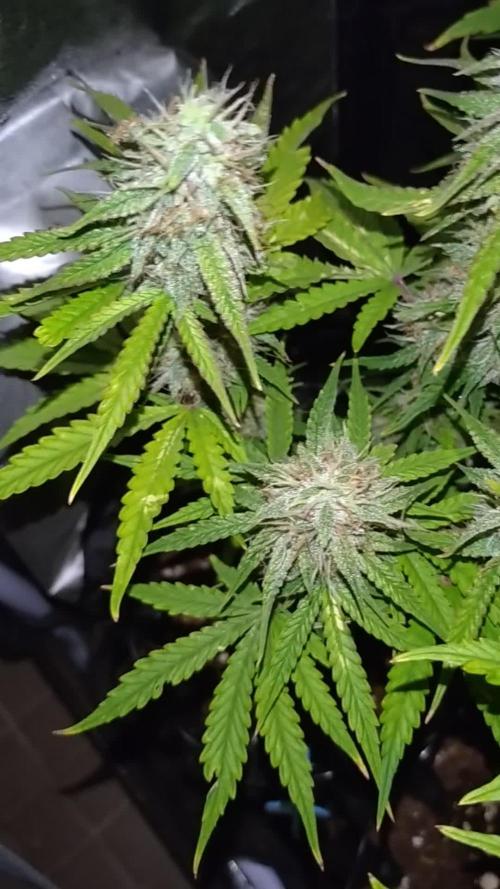The Grow Awards 2026 🏆 































Likes
Comments
Share


@WhiteWidow
Follow
All good so far, will post some divided pics later on when flowers start forming..
Orinoco and critical plus are close to being double in size since i flipped lights to 12 12, they are gonna be huge :)
Likes
13
Share


@NicoKh
Follow
Was a little bit challenging for me, due to the outdated nutrients table, mostly on the Flowering period, also little thing like i have to fill more the pots, also with this kind a strain and also with cuts instead of seeds, may be is better to don't do the topping and don't loose time and energy on the vegetative period. At the same time, more or less about the 8th week of flowering it starts to appear something like Alternalia or Overfeed of Phosphor still don't sure. All this issues have impact the grow in terms of the size of the branches and the whole plant, the size of the buds and the hardness.
In strictly terms about the strain, the quality is out of mind, amount of resin is crazy, just have to improve my skills and get bigger crops
Likes
20
Share


@SKUDUDUBAW
Follow
As you can see my ladies are growing well. The pistils are starting to get purple on the runtz muffin. It starts smelling a little bit and they drink a lot of water!
Happy growing :D
Likes
2
Share


@PhinolaGreen
Follow
8. Woche
So langsam wird es was mit Titan F1 von RQS. Denke 2-3 Wochen noch, dann sind sie rdy to Harvest 😍
Likes
6
Share


@KcKush
Follow
*Transplanted into 3 Gallon fabric pots using Happyfrog.
*Tested soil PH reading of 6.1 added 1tsp of lime.
*Feed Plants 1-6 with Advance Nutrients and Humic Acid PH Seemed to be 7.1
*Feed 7-11 with 20-20-20, Humic Acid, and Blueplanet CalMag. PH was 6.5
*All put under Spider Farmer SF 4000 at 26-28 inch 35%. Will lower everyday.
*Lets see how many females we get.
Likes
7
Share


@GrowInBavaria
Follow
16.12.2026-BT44-17.12.2026-BT45
Es wurde weiterhin nach Schema gegossen. Hier einmal die aktuellen Ein- und Ausgangswerte von pH und EC:
Zoap Rose:
Eingang pH/EC: 6,8 / 0,7
Ausgang pH/EC: 6,2 / 1,4
Apples & Oranges:
Eingang pH/EC: 6,7 / 1,0
Ausgang pH/EC: 6,1 / 2,1
Clementine Slush:
Eingang pH/EC: 6,9 / 0,7
Ausgang pH/EC: 6,1 / 1,6
Mir scheint es, als wäre vor allem Apples & Oranges aktuell sehr stark gesättigt. Die Trichome wirken bereits überwiegend milchig bis leicht bernsteinfarben, weshalb es gut möglich ist, dass diese Pflanze in naher Zukunft geerntet wird.
Zusätzlich darf ich demnächst die DryRocket testen, worauf ich mich sehr freue. Ein Teil der Ernte wird mit der DryRocket getrocknet, ein anderer Teil zum Vergleich mit DryFerm Bags.
Kurzinfos zur DryRocket:
DryRocket ist ein app-gesteuerter Trockner für Cannabis-Blüten, der speziell für Homegrower entwickelt wurde. Das Gerät regelt die Luftfeuchtigkeit automatisch auf Basis des VPD-Werts, wobei die vorhandene Umgebungstemperatur als Referenz dient. So wird eine gleichmäßige und schonende Trocknung ermöglicht, Temperaturschwankungen werden automatisch berücksichtigt und ein manuelles Nachjustieren ist nicht nötig. Dadurch bleiben mehr Aroma und Wirkstoffe erhalten, während das Risiko von Schimmel deutlich reduziert wird.
Der Trocknungsprozess läuft in einem geschlossenen System, dauert in der Regel etwa 8–12 Tage und fasst bis zu 1 kg frisches Pflanzenmaterial. Die Steuerung erfolgt bequem per Smartphone. Zusätzlich kommt ein spezielles Trocknungsgranulat („RocketFuel“) zur optimalen Feuchtigkeitsregulierung zum Einsatz. Für beste Ergebnisse sollte die Umgebungstemperatur im Growraum möglichst zwischen 15 und 22 °C liegen.
Für weitere Informationen könnt ihr gerne hier vorbeischauen:
👉 https://dryrocket.com/
Likes
200
Share


@Ferenc
Follow
Day 79, 28th of November 2020:
Hi there! Here we go let's say half way. Plants are pretty these Original Sensible Seeds genetics are fantastic! The 2 OG and the Runtz Gum is very strechy.
Black Ghost is pretty shorter bushier plant. Runtz Gum and Do-Si-Dos OG approx the same height Do-Si-Dos OG is taller a bit.
Wedding Gelato is really cool little, bushy anf nice buds forming not problem with her all she is quiet.
Do-Si-Dos OG has some deficiency and leaf gets dry but nothing very serious.....
Fertilization is still the same every second day with the rationand mixture above stated.
The lamp is on 11.15 min and off 12.45 min.
Last week was 15 min longer light cycle....
So every week 15 min shorter light cycle until the 5th week. So far -45 min. It switches on at 6 am and off at 17.15 pm.
Likes
15
Share


@Sergi0
Follow
No les pude dar mucha bola esta semana, pero hoy para la foto les estuve sacando hojas amarillas, y las estoy regando con agua con vinagre nomas, seguro que la semana que viene cosecho, o quizás la siguiente si todavía no están jeje...
Likes
11
Share


@Bncgrower
Follow
Another week is over, and on the 12th it's time to harvest ✂️, it wasn't one of my favorite crops, the plant's growth was very irregular, but I hope that after drying and curing it will be worth it. I'll update as soon as I have my first impressions 🌱✌️🍁💨
Likes
25
Share


@MaxMo8
Follow
I transferred it to a half-gallon pot and I mixed the organic fertilizer with the soil.
Likes
51
Share


@cheetah844
Follow
She just gets bigger everytime I see her. I'm excited to watch her grow into what will hopefully be, a beautiful flower filled plant.
I topped every bud site on every plant, both indoors & outdoors.
Processing
Likes
3
Share


@Yaba_dabber_do
Follow
It took 80 days from seed to harvest and a further 9 days to dry as i couldn't keep the temp low enough but that was my problem and 352g of dry curable bud back is amazing for an autoflower in my opinion, especially grown in coco
Likes
12
Share


@Xpie77
Follow
✂️ Oogst & Droging
Aantal planten: 5
Verwachte opbrengst: ±30g per plant
Totaal verwacht: ±150g droog gewicht
Status: Hangend te drogen in een donkere ruimte, 18–19°C bij 55% RV
Verwachte droogtijd: 7–10 dagen, daarna start de curingfase
De geur is tijdens het drogen al zeer intens: een combinatie van zoete bessen, kush en gas. Toppen zijn compact en rijk aan trichomen.
---
🔜 Wat volgt
Zodra de toppen voldoende gedroogd zijn (stelen breken met een ‘snap’), start het curingproces in glazen potten. Dit zal het terpenenprofiel nog verder verdiepen.
---
Eerste conclusie:
Zeer sterke run met Blue Zushi. Alles wijst op een premium eindproduct, met een goede balans tussen geur, smaak en potentie. Eindbeoordeling volgt na curing & testsmoke!
Likes
57
Share


@Bread_n_Buds
Follow
Black Runtz is a crazy beauty, a black isolated phenotype of the very famous Zamnesia Runtz, in the last week you will find the white phenotype with a green apple flavor but going back a week you will find the black one honestly more beautiful to look at even if this is no joke at all, especially for resin.
**Remember that for all varieties we have at least two plants, one left to grow straight and one worked with the techniques. This is the plant worked with a topping, the harvest of the other is precisely in the next week.
Technique used // In this case we let the plant grow up to the 4th internode and we cut, then repeated toppings until we reached 16 growing branches. After the second week of flowering we eliminated the branches that would not have seen too much light to strengthen the others.
Better with the techniques or normal ones? This time we have two very different phenotypes, a plant with medium internodal distance this time I prefer the plant left to grow straight but I know that it can be done very well with a main lining.
Flower quality // From one to 10 stars 15. The plant has resined very well on all sides the resin is really abundant and above average. The buds have been washed as recommended by Zamnesia.
Check the article in your language // https://www.zamnesia.io/it/guida-growing-cannabis/333-lavaggio-delle-ceme
Fertilizers// I am very happy with how I managed to unload the plant that at a certain point before going to flush was fed for a few days only with additives and then went to flush and we are very very well discolored, I predict a very tasty flower, grown organic and flushed successfully, the flavor and taste will be epic.
All Plagron fertilizers and additives in the green/100% organic version have fully satisfied me. Choose your soil according to your style and calculate the sheet on the website www.plagron.com -
Brother if you are stubborn use additives listen every now and then.... and then come and tell me.
The fertilizers instead can be found in convenient all-inclusive packages on the Zamnesia website.
This variety is already a legend in the normal version, imagine in the Black version... try it!
---- https://www.zamnesia.io/it/11159-zamnesia-seeds-black-runtz.html
Zamnesia Description // Black Runtz descends from a truly legendary genetic heritage. Our breeders have used three modern classics from the United States to create this variety: Zkittlez, Gelato and Runtz. With 20% THC and flavors of grapes and berries, Zkittlez has transmitted its delicious flavors and relaxing effects. Gelato contributed to Black Runtz's immense flavor profile by imparting high concentrations of the terpenes limonene and humulene. Finally, Black Runtz inherited the high potency of the original Runtz, a strain with a respectable 21% THC. The end result of this 3-way cross is a strain with 55% indica genetics and 45% sativa. Black Runtz boasts a fast flowering time, very high potency, and contrasting yet balanced terpenes that support its delicious flavor profile.
Music and Frequencies // For about 4-6 hours a day my plants listen to 432Hz frequencies specially created for their well-being and sometimes a bit of black music to give them those vibes that only music can give. www.radionula.com
All the best that mother nature has to offer is at ---- www.zamnesia.com
Likes
3
Share


@mftexans420too
Follow
Week 3/4 preview of inside 3 tents. I’m learning how to navigate through ruff time amen Sundae it
Likes
12
Share


@Jays_Not_Here_Man
Follow
Temps have been good and RH has been steady between 60-65%. I have good airflow all around and don’t worry too much about it the higher RH at this point in the grow. Transplanted the ladies from their starter pots to their 2 gallon pots. They did not seem to have any transplant shock. A few more weeks and we will go to their 4 gallon final pots.





























